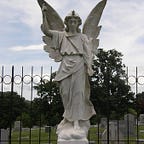The Murder of Nell Cropsey
Episode 8: The Weirdness that Followed
Once James Wilcox returned to live in Elizabeth City after his pardon and release from prison, his activities continued to make the news. When he fell and broke his ribs, it made the news. When he was in a car accident, it made the news. The actions of any of the major players in the trials made the news as soon as the final verdict was passed and continued to do so long after. A juror committed suicide in 1904; Nell’s father was wrongly rumored to be dead in 1906; in 1908, Guy Hall, a staunch supporter of Wilcox, was involved in a scheme to sully the honor of a young woman. The attorneys and doctors began to die. Every article and obituary made more than a mere mention of their ties to the famous case.
Tragedy hit the Cropsey family again in 1913 when, in Norfolk, oldest son, William H. Cropsey, Jr., committed suicide. This was fodder for many rumor mills as a tragedy begat by a tragedy. Cropsey’s wife, however, stated that he had alcohol and financial problems that led him to take his own life. It did not stop newspapers from reporting that the man was worried about the possibility of parole for Jim Wilcox. He was even reported to have said, “There is one thing left for me to do as a protest against that…”
Reporters continued to hound James Wilcox to tell his story and met with rejection — with one notable exception. W. O. Saunders, then editor of the Independent in Elizabeth City, finally got Wilcox to agree to talk to him. In 1902 and 1903 Saunders had been a young reporter for the Norfolk papers during the sensational trials.
In 1915, rumors abounded that Wilcox was near death in prison. He did, indeed, have tuberculosis and was confined to Central Prison’s hospital. During that illness he finally spoke to Saunders, who asked him if he had any theory as to who had harmed Nell Cropsey. Wilcox answered, “None in the world.” The reporter stated, “It struck me that a guilty man would in twelve years have fabricated a dozen explanations to vindicate himself…one would think that a murderer protesting his innocence and hoping for pardon would have concocted all sorts of theories to square himself.” Saunders encouraged Wilcox to make a statement or even write it out. He did not, however, and the reporter kept trying. Then in 1934 at age 58, sick and fueled by alcohol, James Wilcox shot and killed himself and all hope of a statement was lost.
Or was it? With this death, only two principals in the case remained, Ollie Cropsey and her father. Saunders wrote long articles in The Independent after Wilcox’s suicide. He said that he had been meeting with him since 1932 about writing his story. The convicted murderer stated to a friend that Cropsey’s father could have told who had killed his daughter but that he had chosen not to do so. Interviewing some of his friends, Saunders learned that Wilcox had been writing and was storing the pages in a tin box that he buried on Frog Island. Wilcox told his friend that he could have and publish them if he could find them. The pages have never been found and the profound mystery of what happened to Nell Cropsey may never be known.
~by Debbi Blake
Stay tuned for the #FolksongFriday post for details on Nell Cropsey murder ballads — coming Friday Aug. 16.
